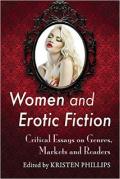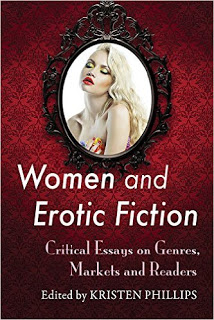Paraphrasing and Misleading: Inguenues, Madonnas, Virgins and Whores
Sometimes, an author/critic can be quoted out of context so that it appears they're saying something they didn't mean. For example, if I summarised an argument I disagreed with and someone then quoted my summary and attributed it to me but didn't say that I was summarising arguments I disagreed with, they'd not be misquoting me, but they would be giving a misleading impression of my opinions.
Another possiblility is for someone to paraphrase an argument or statement in a way which significantly alters its meaning. Here's an example I've just come across from an article by Victoria Kennedy about Philippa Gregory's work of historical fiction, The Other Boleyn Girl, in which romance fiction in briefly discussed so that the conclusions drawn about it can be used to analyse Gregory's novel:
Regis notes that romance novels are defined by their happy endings (9) and their ingénue heroines (49). The virgin and the whore appear as standard archetypes in romance narratives, but, as Regis explains, the virginal ingénue is the usual heroine of a romance novel (49). This figure, according to Janice Radway, allows the “ideal romance” narrative to deal with female sexuality “by confining the expression of female desire within the limits of a permanent, loving relationship” (169). Indeed, the element of “love” is central to the ideal romance heroine. As Helen Hughes notes of the genre’s typical heroine, “a woman who wants love is a sympathetic figure” (112). The ingénue’s opposite – the whore, seductress, or fallen woman – is a figure that severs the link between love and sex and is consequently denied the happy ending of matrimonial bliss granted to the heroine at the conclusion of the narrative. (50-51, emphasis added)
It seems extremely odd that Kennedy would describe "ingénue heroines" as a defining feature of the romance novel given that that just before this passage Kennedy had listed the eight elements which Regis does describe as defining:
Regis outlines eight narrative elements that she says define the romance novel: a depiction of corruption within society that the romance will reform; the meeting of heroine and hero; their attraction; a barrier to their relationship; a symbolic or literal death; the overcoming of the barrier; the declaration of love; and the betrothal. (Kennedy, 50)
Clearly, ingénue heroines are not among the eight essential elements of a romance listed by Regis.
I think there is, moreover, a significant difference between the statement "the virginal ingénue is the usual heroine of a romance novel"(51, emphasis added) and what Regis actually wrote on page 49 of A Natural History of the Romance Novel, which is "the ingenue heroine [is] frequent in romance novels" (49). Admittedly neither "usual" and "frequent" are precise terms, but it seems to me that something might be frequent if, for example, it happens in one book in ten. If something is usual I'd expect it to happen in fifty percent or more cases.
Changing "frequent" to "usual" matters, then, and it makes a difference because it's a building-block in Kennedy's argument, which leads her to conclude that:
A great deal of the tension between feminism and the romance, I suggest, lies in the fact that the romance’s formulaic female archetypes represent precisely the static female identity positions that feminism has long fought to undermine: the madonna and the whore. (54)
It seems rather ironic to reduce romance heroines to just two archetypes while arguing, from a feminist perspective, that feminism "has long fought to undermine" "static female identity positions".
Regis, it should be noted, was taking a historical perspective on the romance and it's certainly true that, in the past, virgin heroines were probably the norm (i.e. more than 50% of heroines). Even then, though, you could find exceptions. Georgette Heyer's Babs, in An Infamous Army (1937), is a widow with a distinctly un-madonna-like reputation and history.
It should also be noted that the heroines of The Grand Sophy (1950), The Masqueraders (1928), and Venetia (1958), to give just three examples, though virgins, are hardly "ingénues": an "ingénue" is "An innocent or unsophisticated young woman" (Oxford Dictionaries) and Sophy, Prudence and Venetia are neither.
While it is true that virgin heroines are still "frequent" in romance novels they're far from ubiquitous and the impression I have is that, outside historical romance, inspirational romance and particular lines such as Harlequin Presents/Mills & Boon Modern they probably don't make up over 50% of heroines published in recent years. Even in the sample of early twenty-first century sheikh romances analysed by Amy Burge, "Of the fifty-seven sheikh novels published in the Modern Romance series, at least thirty-two feature virgin heroines" (89-90) and that's in a sub-genre within that line in which "virginity is a particularly prominent trope" (89).
Anyway, not having done a statistical analysis of heroines' levels of sexual experience and knowledge, I can't speak confidently about the precise percentages of recently-published romances which contain virgin heroines but (a) I don't think it's particularly helpful or accurate to assume that romance only depicts women as "madonnas" or "whores" and cannot conceive of a wider spectrum of sexual knowledge and experience among heroines, (b) I don't think it's accurate to imply that "madonnas" are "the usual" type of heroine in the romance novels currently being published and (c) I don't think it's possible to support such an argument on the basis of a paraphrasing of a passing comment by Pamela Regis.
----
Burge, Amy. Representing Difference in the Medieval and Modern Orientalist Romance. Houndmills, Basingstoke: Palgrave Macmillan, 2016.
Regis, Pamela. A Natural History of the Romance Novel. Philadelphia: U. of Pennsylvania P, 2003.
Kennedy, Victoria. "Revisionary Historical Metatext or 'Good Mills and Boon'?: Gender, Genre, and Philippa Gregory's The Other Boleyn Girl." Pivot 5.1 (2016): 42-74.


 Carole Veldman-Genz's "focus is on a particular strand of erotic romance fiction for women published by market leader Ellora's Cave under the copyrighted term romantica" (134), namely their
Carole Veldman-Genz's "focus is on a particular strand of erotic romance fiction for women published by market leader Ellora's Cave under the copyrighted term romantica" (134), namely their Simon Hardy's essay in this volume compares the "male tradition of pornographic writing" which made "use of a female narrative voice" to "erotic fiction and memoirs [...] that are genuinely written by women" in order to discover whether "female authors are producing new forms of erotica or simply assimilating patterns of erotic discourse established by the centuries-old tradition of male writers, often masquerading as female autobiographers" (25).
Simon Hardy's essay in this volume compares the "male tradition of pornographic writing" which made "use of a female narrative voice" to "erotic fiction and memoirs [...] that are genuinely written by women" in order to discover whether "female authors are producing new forms of erotica or simply assimilating patterns of erotic discourse established by the centuries-old tradition of male writers, often masquerading as female autobiographers" (25). Kristen Phillips recently posted me a copy of Women and Erotic Fiction: Critical Essays on Genres, Markets and Readers, an essay collection she edited. Those essays discuss and explore a wide range of texts but it is the publication of, and responses to, Fifty Shades of Grey, which has focused attention on women's erotic fiction. Of course, as Phillips notes,
Kristen Phillips recently posted me a copy of Women and Erotic Fiction: Critical Essays on Genres, Markets and Readers, an essay collection she edited. Those essays discuss and explore a wide range of texts but it is the publication of, and responses to, Fifty Shades of Grey, which has focused attention on women's erotic fiction. Of course, as Phillips notes,